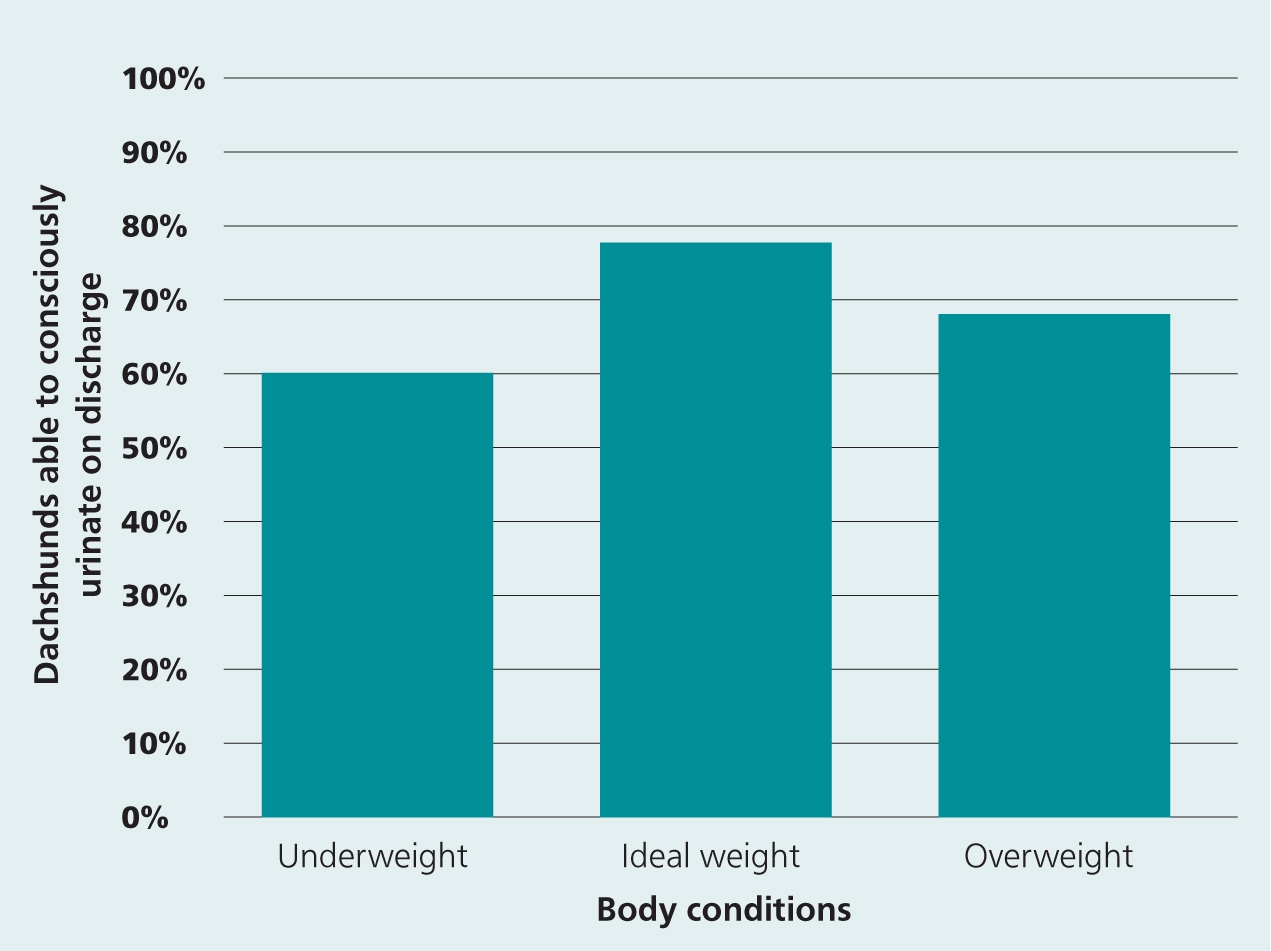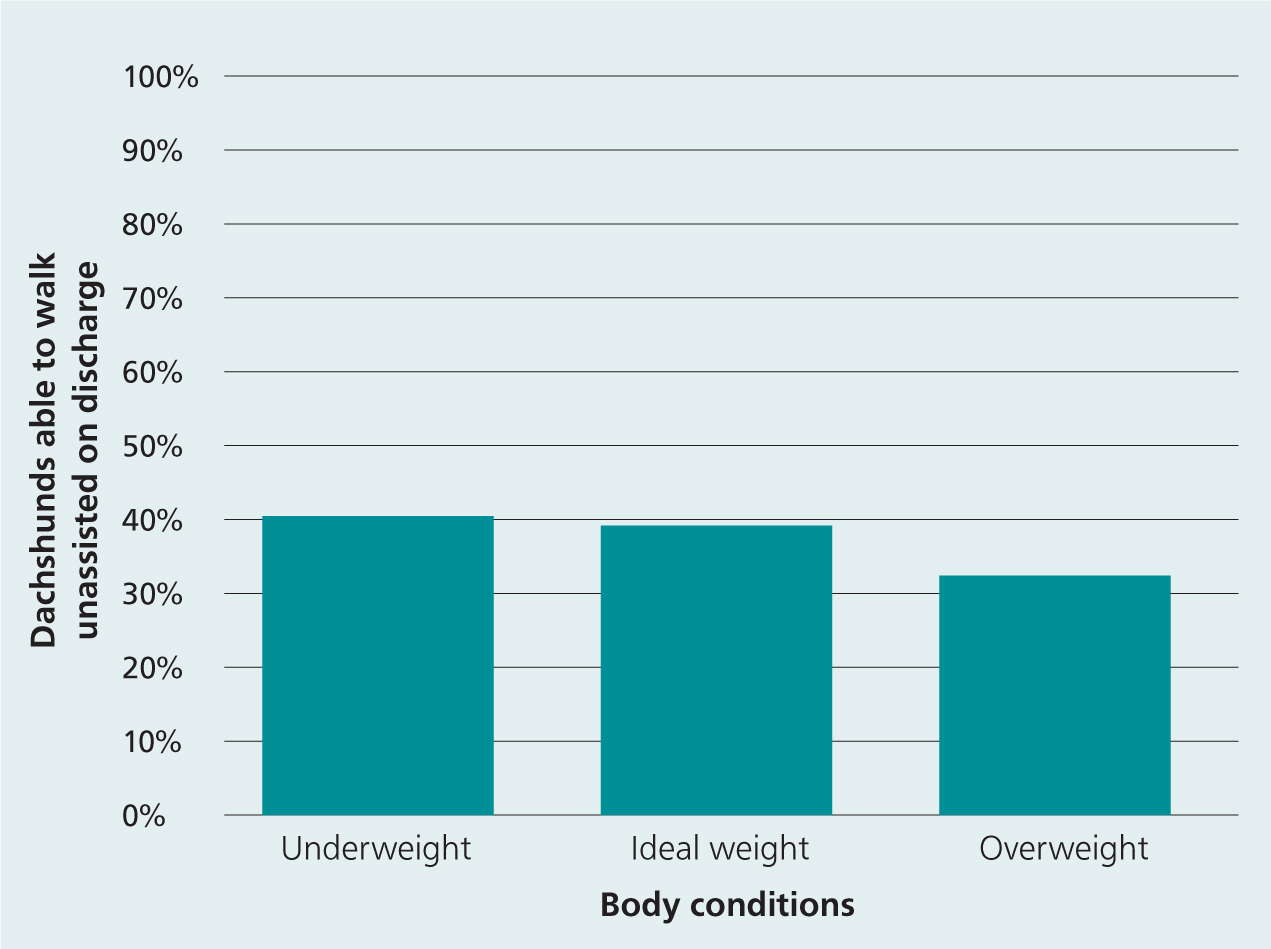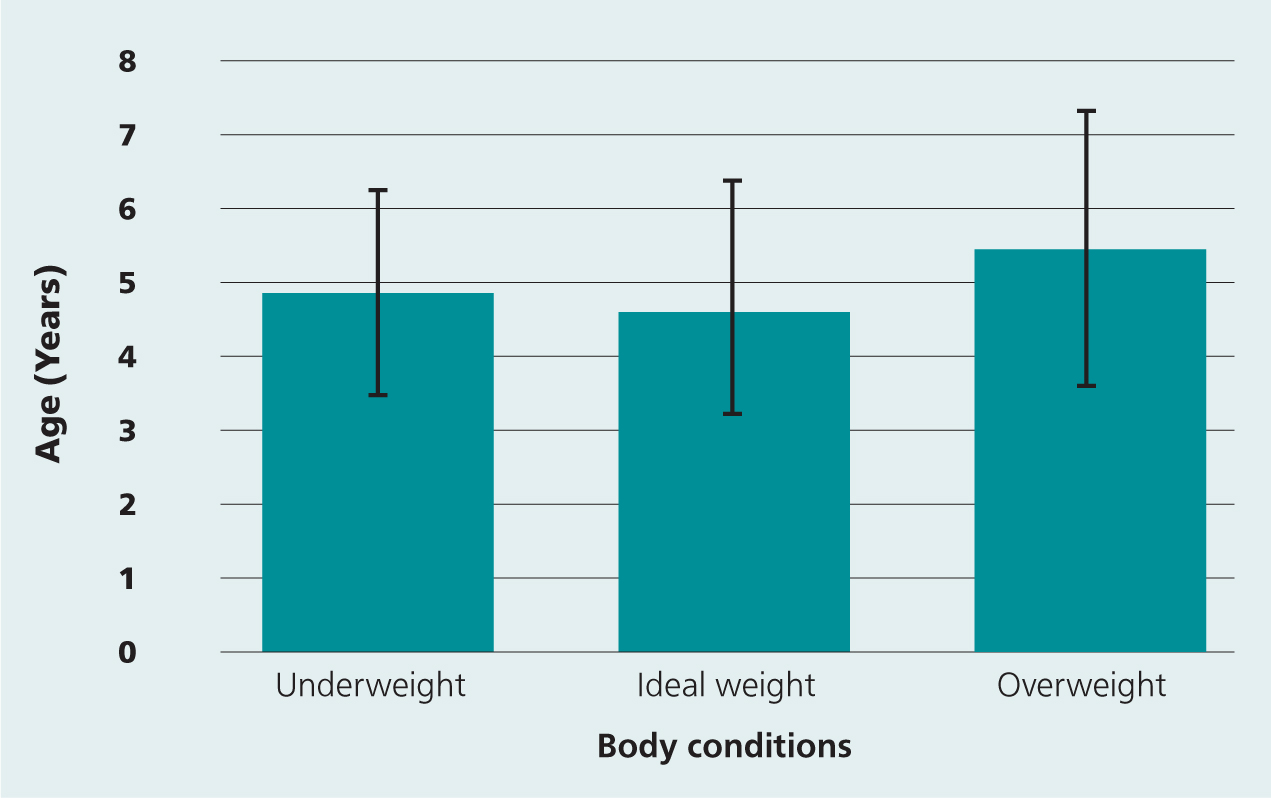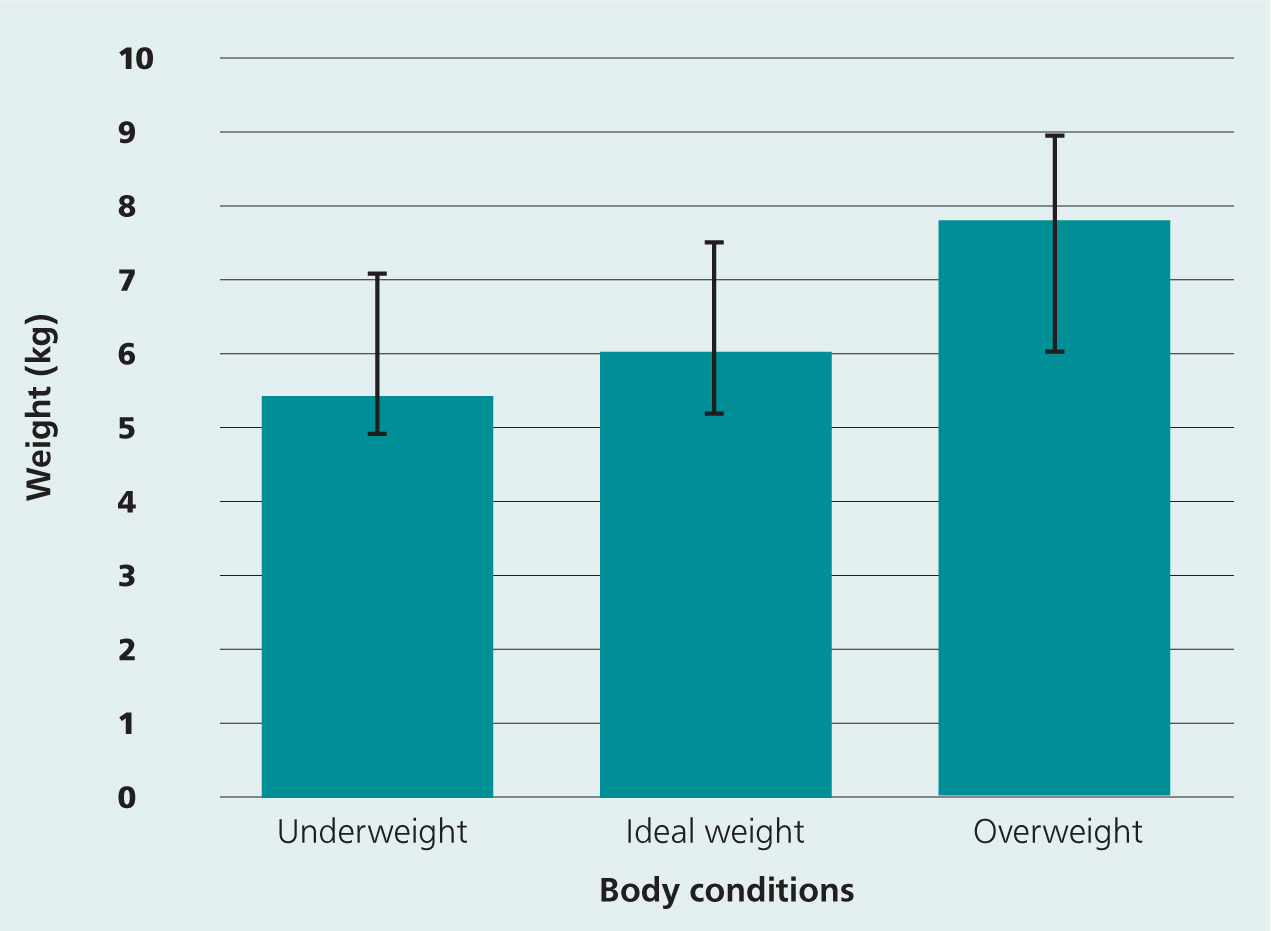Dachshunds, a chondrodystrophic breed, have the highest risk of intervertebral disc disease (IVDD) of all dog breeds (Bergknut et al, 2012). They typically develop Hansen type 1 IVDD, in which the nucleus pulposis herniates through the outer disc and presses on the spinal cord (Hady and Schwarz, 2015).
Packer et al (2013) claimed that dogs with higher body condition scores (BCS), regardless of breed, were more likely to develop IVDD. Packer et al's (2016) retrospective cohort study found that dogs having less exercise have increased risk, perhaps as a result of increased BCS or reduced muscle supporting the spine. However, only limited research has been carried out on the relationship between BCS and recovery times after IVDD surgery (Williams and Barone, 2012).
In their prospective observational trial, Gordon-Evans et al (2019) found no correlation between obesity and recovery times in Dachshunds following hemilaminectomy and rehabilitation, but higher IVDD grades slowed recovery. The mean BCS was 6.7, higher than the ideal 4–5/9, with more overweight than healthy or underweight Dachshunds participating. The sample size was only 32, which might have produced unreliable results, although some may argue the sample was sufficient to find correlation between IVDD grade and recovery time. Sample size should be calculated to ensure future results are reliable.
Williams and Barone (2012) found that patients with a BCS below 7/9 were 7.62 times more likely to recover within 4 weeks. The recovery time they used was number of days taken to walk without assistance. Hady and Schwarz (2015) used three steps without assistance and Jeffrey et al (2016) used time to take ten steps unassisted without falling. Discharge goals often include pain management through providing adequate analgesia and ability to walk and consciously urinate (Fitzpatrick Referrals, 2021). Using ability to walk, alone, is arguably insufficient. Future research should consider pain management as well as days to walk and urinate.
Vertebral site numbers were not considered by Williams and Barone (2012), potentially impacting results. Higher site numbers increase IVDD grade (Hady and Schwarz, 2015). Heblinski and Schmökel (2018) found higher IVDD grades are associated with increased time to walk, but no correlation between location of IVDD and prognosis. The number of sites should be considered in future research.
Studying Dachshunds specifically, Dorn and Seath (2018) found higher statistical significances in IVDD rates between neutered and entire females than between male equivalents. Increased IVDD in neutered patients could be linked to neutering associated bodyweight gain. Belanger et al's (2017) retrospective study found neutered females had 70% increased IVDD risk compared with entire females, but no association with neuter status in males. Hady and Schwarz's (2015) retrospective study found neutered females had more successful recoveries than neutered males.
Jia et al (2016) demonstrated that in ovariectomised rats, intervertebral disk endplates became calcified, reducing nutrient supply. Oestrogen supplements increased nutrient flow to discs, slowing IVDD progression. This connection between neutering and IVDD questions the link being a result of weight gain. Future research should document gender and neuter status.
The only clinical sign that negatively affects prognosis is absence of deep pain perception (Heblinski and Schmökel, 2018), with Hady and Schwarz (2015) finding only 50% of dogs improving. It is impossible to identify the precise timing of loss of deep pain. Jeffrey et al (2016) studied intervals between owners noticing clinical signs of IVDD and dogs being unable to walk, and consequent time to surgery. No correlation was found between those intervals. Future research should include recovery times in dogs with no deep pain perception.
In conclusion, existing studies indicate that higher IVDD grade, higher BCS, neutering and less exercise increase the risk of IVDD. The presented studies exploring BCS and recovery time have many limitations. Therefore, a study was conducted to investigate whether BCS is associated with IVDD grade, and whether BCS affects recovery time following thoracolumbar hemilaminectomy in Dachshunds.
Methodology
Study population
Dachshund owners were invited to answer a questionnaire if their Dachshund had undergone a hemilaminectomy for IVDD at least 3 months previously. Owners of suitable subjects were identified online through numerous UK-based Dachshund-related social media groups and pages, including one social media group dedicated to owners of Dachshunds that have had IVDD. The Dachshund IVDD social media group had approximately 8000 members and many had experience of their Dachshunds developing IVDD, making them an ideal sample of respondents. The questionnaire was also shared through the Dachshund Breed Council monthly newsletter.
Owners with experience of more than one dog could complete multiple questionnaires. All questionnaires were answered anonymously. No limit was placed on how long ago the Dachshund had surgery or whether it was still alive but, if a respondent answered ‘I don't know’ in any section, their responses were excluded.
Questionnaire design
The survey was conducted through Online Surveys (JISC, Bristol, UK). The questionnaire contained two sections. Questions in the first section asked about Dachshund variety, age, gender including neuter status, bodyweight at time of developing IVDD, grade of IVDD, number of sites operated on and the BCS using the Dachshund Breed Council scale (2020). The second section asked about days spent in hospital; time to consciously urinate and walk without assistance; pain and analgesia; physiotherapy; full recovery from the owner's perspective; IVDD recurrence; and optional additional comments. No owner demographic information was collected.
Piloting and administration of the questionnaire
A small pilot was conducted involving 13 individuals from the Dachshund Health Committee and Dachshund Health UK trustees. The research received full ethical approval from Harper Adams University. The questionnaire was shared from 11 November 2021 and closed on 11 January 2022.
Data analysis
Questionnaire responses were recorded in JISC and exported to Microsoft Excel. Each factor was analysed individually, examining numbers and percentages for categorical data and mean, median and standard deviation for continuous variables. Histograms of continuous variables were checked to determine whether they were normally distributed. An analysis for any associations between factors was then carried out using Genstat. Statistical tests included the parametric ANOVA test with post hoc Bonferroni test and the nonparametric equivalent Kruskal-Wallis test with post hoc Mann-Whitney U test. A Chi-square test was used to look for associations between categorical variables. The level of significance was set at p<0.05, with a 95% confidence interval.
Results
Responses received
In this study, 309 responses were received and 294 were included. Fifteen were excluded because of unknown IVDD grade, conservative management rather than surgery, cervical rather than thoracolumbar pathology or complications affecting recovery time, e.g. pneumonia.
Of the 294 Dachshunds included, 55.1% were male (42.2% neutered) and 44.9% were female (35% neutered). The most popular variety of Dachshund was the miniature smooth haired (65%), followed by standard smooth haired (11.9%), miniature long haired (9.2%), miniature wire haired (3.4%), standard long haired (2.7%), standard wire haired (2.4%). Cross variety Dachshunds (3.1%) and crossbreed Dachshunds (2.4%) were also included. There was a range of Dachshunds in each of the 9 body condition scores. Most Dachshunds were at an ideal bodyweight (62.2%), followed by overweight (30.9%) and underweight (6.7%). Bodyweight ranged from 3.2 kg to 25 kg, with a median of 6.5 kg.
In this study, over half the dogs were in pain on discharge (55.4%), with 54.4% given analgesia. Of the 43.5% not in pain on discharge, 38.1% were given analgesia. The other 1% of owners did not know if their dog was in pain. Most subjects had one site operated on (58.8%); however, some subjects had operations on two sites (21.4%), three sites (8.5%), four sites (1.4%) and five or more sites (4.8%). The remaining 5.1% of owners did not know how many sites were involved.
At the end of the questionnaire there was an invitation to add any additional comments that owners thought would be relevant. Comments were left by 114 owners.
For the purpose of analysis the subjects were categorised into three groups: underweight (BCS 1–3), healthy body-weight (BCS 4–5) and overweight (BCS 6–9).
Impact of body condition score on intervertebral disc disease grade
Body condition score had no effect on IVDD grade (H=1.139, df = 2, p=0.566). The median (1st and 3rd quartile) IVDD grade for underweight was 4 (2.75–5), ideal weight 4 (3–5) and overweight 4 (3–5).
Impact of body condition score on recovery time
Body condition did not affect duration of hospital stay (H=1.301, df=2, p=0.522). The median (1st and 3rd quartile) duration of stay for underweight was 4.5 days (3–6), ideal weight 4 days (2.5–6) and overweight 4 days (3–6.5).
The percentage of dogs able to consciously urinate on discharge was higher in ideal weight than in underweight and overweight subjects (Figure 1). However, there was no significant association between body condition and ability to consciously urinate on discharge (x2=4.73, d.f=2, p=0.094).

Body condition did affect number of days to consciously urinate (H=7.628, d.f=2, p=0.022). Post hoc testing, using the Mann Whitney U Test, indicated that overweight patients took significantly longer to consciously urinate than those of ideal weight (U=4999.5, sample sizes = 154, 80, p=0.016). There was no significant difference between ideal and underweight (U=968.5, sample sizes = 154, 17, p=0.079) or overweight and underweight (U=631.5, sample sizes = 80, 17, p=0.647). The median (1st and 3rd quartile) days to urinate for underweight was 3 days (2–7), ideal weight 1 day (1–4) and overweight 2.5 days (1–6.25).
There was no significant association between BCS and ability to walk without assistance on discharge (Figure 2) (x2=3.90, d.f=2, p=0.142). Most dogs in all categories needed assistance to walk on discharge. There was also no effect of body condition on number of days to walk without assistance (H = 4.463, d.f = 2, p = 0.107). The median (1st and 3rd quartile) number of days to walk without assistance for underweight was 12 days (2.5–21), ideal weight was 7 day (1–19.25) and overweight was 10 days (4–28).

Other findings
ANOVA indicated a significant difference (p=0.001) in ages between different body conditions. Post hoc analysis (Bonferroni test) revealed a significant age difference between ideal weight and overweight, but not between under-weight and ideal bodyweight or between underweight and overweight subjects. The mean (±stddev) age was 4.9 years (±1.29) for underweight, 4.6 years (±1.55) for ideal weight and 5.4 years (±1.75) for overweight (Figure 3).

The relationship between BCS and bodyweight (kg) in this sample was confirmed (H=22.06, d.f=2, p=0.001). Post hoc testing using Mann Whitney U Test indicated a significant difference between overweight and ideal weight (U=5298.5, sample sizes = 183, 90, p=0.001) and between overweight and underweight subjects (U=486.0, sample sizes = 90, 20, p=0.001). There was no significant difference between ideal bodyweight and underweight (U=1567.5, sample sizes = 183, 20, p=0.293). The median (1st and 3rd quartile) for underweight was 5.6 kg (4.95–7), ideal weight 6 kg (5–7.5) and overweight 7.7 kg (6–9) (Figure 4).

Discussion
The first objective of this study was to identify whether there was a significant difference between IVDD grades in each weight group. No significant difference was found. No other authors have considered this comparison. This eliminates this as a potential confounding factor in the results found.
The second objective was to determine whether BCS had an impact on recovery time. Recovery for IVDD patients includes regaining conscious urination and a statistically significant difference was identified, with overweight dogs taking longer than those of ideal bodyweight. However, there was no significant difference when comparing overweight with underweight dogs or dogs of ideal body-weight with those that were underweight. Other research using urination to evaluate IVDD recovery time is limited. Gordon-Evans et al (2019) found no associations between BCS and days to urinate. Their median was 4 days for the entire population while the current study recorded 3 days for underweight, 1 day for ideal weight and 2.5 days for overweight subjects. Their study did not include grade 5 patients whereas, in the current study, the majority were grade 4 or 5 and so a higher median would be expected. Dachshunds still unable to urinate at the time of the study were excluded from this data analysis.
In this study, BCS was not associated with days taken to walk after hemilaminectomy or ability to walk on discharge. Gordon-Evans et al (2019) also found no significant effect on days to walk. The median days to walk in their overweight population was 7 days, the same for the ideal bodyweight patients in the current study. This study measured 12 days for underweight patients and 10 days for over-weight. Williams and Barone (2012) did report a significant association between BCS and time taken to walk but they did not state the period of time involved. Gordon-Evans et al (2019) noted that IVDD is commonly associated with muscle weakness, so being overweight could delay walking. However, underweight patients may also have muscle weakness and this may explain why it also took under-weight dogs longer to walk in the current study.
As most patients were on pain relief on discharge (92.5%), there was nothing to investigate statistically. This would have been expected after a hemilaminectomy, which is perceived to cause intense pain in dogs (Matthews et al, 2014). Postoperatively, tissue from intervertebral discs may be present in the vertebral canal or press on nerve roots, contributing to ongoing pain (Brisson, 2017). Pain is at its highest in dogs within 24 hours postoperatively (Ferrarin et al, 2021) and so dogs discharged on the same day or the following day may have been in pain despite analgesia. However, with prescribed analgesia, less than 55.4% would have been expected to be in pain. Although only 1% of respondents said they did not know how to answer questions on pain, future studies may want to provide a pain scale or include signs of pain to help owners be more precise in their judgement.
Owners were asked the bodyweight and BCS of their Dachshunds at the time of surgery. The heaviest Dachshund in the current study was 25 kg, more than twice the bodyweight of the breed standard maximum bodyweight of 12 kg (Dachshund Health UK, no date). Therefore, it is possible that this individual 25 kg is incorrect.
Ages of the overweight Dachshunds were significantly higher than in the ideal weight Dachshunds. Mawby et al (2004) also found this correlation in their study. Packer et al (2016) found age increased the risk of IVDD, concluding it may be a result of degenerative changes. Mawby et al (2004) suggested it was because all dogs in their overweight category were neutered, compared with 80% of the healthy weight dogs. Neutering increases risk of being overweight (Laflamme, 2006). This was not explored in this study. For Dachshunds, it is recommended that neutering should be carried out at a minimum age of 12 months and, for females, neutering at any age increases the risk of IVDD (Dorn and Seath, 2018). Older Dachshunds, therefore, are more likely to be neutered. This finding can, therefore, be accepted.
The main limitation of this retrospective study is that it relied on owners to provide historical information. Owners could misunderstand questions or misremember information (Dorn and Seath, 2018) affecting the results. Gordon-Evans et al's (2019) study found that owners providing durations and progressions of clinical signs were inaccurate and did not use those data for analysis.
Another limitation in this study was that owners could have responded less than 3 months postoperatively, which could invalidate their answers about full recovery. Gordon-Evans et al (2019) used patients' ability to independently walk 3 months post-operatively as their primary outcome measure. Jeffrey et al (2016) reported that 58% of grade 5 patients could walk independently within 3 months of surgery. Therefore, it is arguable that grade 5 patients assessed within 3 months of surgery should have been excluded.
This study utilised a 9-point, breed specific BCS with images of Dachshunds that owners may relate to. BCS is quick, inexpensive and non-intrusive, but limited by subjectivity (Gordon-Evans et al, 2019). However, Mawby et al (2004) found that BCS correlates well with accurate dual-energy x-ray (DEXA) absorptiometry, which accurately measures body composition by estimating body fat percentage in the body (Jeusette et al, 2010). Packer et al (2016) used a 5-point scale and concluded that owners were unreliable in their assessments of BCS but noted that a 9-point scale may be a more sensitive tool. A BCS scale of nine is most widely accepted (German et al, 2006).
Gerstner and Liesegang (2017), using a 9-point scale, demonstrated that owners significantly underestimated BCS, scoring their pets a mean of 4.54 while two veterinary surgeons scored them 5.20. However, that study of 78 dogs included 38 breeds and 15 mixed breeds. Their BCS scale was a general scale, not breed specific. Jeusette et al (2010), studying methods of measuring body composition, concluded that breed specific BCS is needed to allow for genetic and morphological differences between breeds. Therefore, it was thought by the author that a 9-point, breed specific BCS scale was the best method to use.
According to Martin et al (2020) there is an increased risk of intraoperative complications when out of hours surgery is performed, which may have led to longer recovery times in some patients. This was not considered in this study and may have influenced the results.
Additionally, some owners answered the questionnaire within less than 3 months, which may have not allowed for recurrence. Patients having surgery longer ago had more time to develop recurrence and even multiple recurrences. However, Heblinski and Schmokel (2018) reported that herniation at the operated sites can occur within the first 4 weeks, potentially leading to further surgery. Also, fenestration, which reduces risk of recurrence (Aikawa et al, 2012) was not considered in this study and could have affected the results. Therefore, recurrence in these questionnaires could be unreliable and so no data analysis was carried out.
Packer et al (2016), using an owner survey to investigate IVDD risk in Dachshunds, found that 42.9% were overweight. Dorn and Seath (2018), studying neutering and IVDD, found only 6.6% but concluded this was an underestimate because of reliance on owners reporting their opinion of the BCS. The current study had 30.9% overweight. The same problem would be expected, but the weights in each body condition category were analysed confirming that Dachshunds in the overweight category were significantly heavier than those of ideal weight and underweight. Therefore, these results may be reliable. No significant difference was shown between ideal weight and underweight. In this study, the underweight population (BCS ≤ 3) was 6.7%, which is too small to accurately represent this population.
One hundred and fourteen owners left additional comments and some included details that led to exclusion of those subjects. However, exclusions were not made for irregularities such as paralysis weeks before veterinary assessment; delayed discharge because of practice policy or owner work commitments; or early discharge as a result of stress and inappetence. These were included because they were not neurologic or medical conditions that would interfere with owner reporting or analysis of data (Jeffrey et al, 2016).
Jeffrey et al (2016) studied dogs with no deep pain perception (grade 5 IVDD) and concluded that ability to walk, in isolation, was not a sufficient indicator of recovery. They also used ability to tail wag, which was not considered in this study as it relates only to grade 5. It is not a regular milestone that veterinary professionals look for, with the main concerns being ability to walk, ability to consciously urinate and pain.
Number of sites were not analysed as the majority were one site (58.8%) and two sites (21.4%). Having different BCS groups and multiple categories for site numbers would have made the categories very small.
Conclusions
This study aimed to determine, from a sample of 294 Dachshunds, whether BCS affects IVDD grade and recovery time following thoracolumbar hemilaminectomy. No impact of BCS on IVDD grade was found. However, higher BCS was associated with statistically significant delays in ability to consciously urinate. The return of conscious bladder control postoperatively, is an indicator of successful recovery from hemilaminectomy. The finding that, in Dachshunds, a high BCS delays this aspect of postoperative recovery suggests, for the first time, that obesity negatively affects recovery. This aspect of recovery had not been investigated before. Based on the study findings, it is recommended that Dachshunds are kept at an ideal weight (BCS 4 or 5 out of 9). Veterinary professionals should encourage lifelong maintenance of ideal weight. No conclusion could be made about underweight Dachshunds, because of the small sample size. Further studies should analyse data only from patients that have had surgery a minimum of 3 months earlier. In addition further research is required with confirmed underweight patients because of trends for increased recovery time.
KEY POINTS
- The risk of developing intervertebral disc disease (IVDD) can be increased by multiple factors, including a higher body condition score (BCS).
- No association has been established between BCS and IVDD grade.
- This study has found that, following surgery for IVDD, overweight dogs take longer to regain the ability to consciously urinate than healthy weight dogs.
- No association has been established between BCS and days to walk unaided or days hospitalised.
- Further studies should analyse data only from patients that have had surgery a minimum of 3 months earlier.


